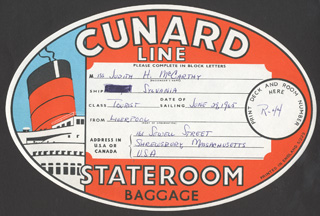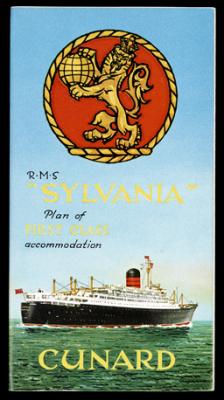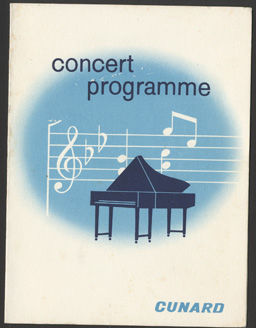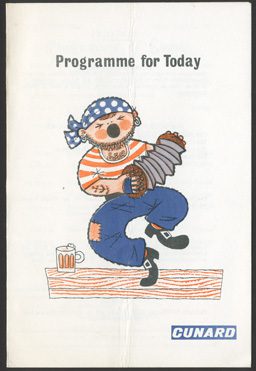
Traveling aboard an Ocean Liner immersed passengers in different surroundings, activities, social relationships, and new ideas. This new environment forged passengers and crew into a unique community. This experience presented Judith and her fellow travelers opportunities and experiences largely absent from other modern modes of transportation.
Ocean liner companies tended to promote the amenities available to the first-class travelers, as shown in the following images. Tourist-class travelers aboard the Sylvania, such as Judith, would have experienced a lower level of amenity.
“The room is beautiful. It’s a good thing the other girl didn’t show up here; there never would have been enough room for the two of us. One thing I like – draw curtains beside the bed, just like in the movies and all that.”
“Tony told me that I was sitting right over the hold. I was sure it was the engine room.”

A tourist-class baggage tag from Judith’s return voyage to the United States. Her room number is listed as R-44.

A plan of Sylvania’s tourist accommodations. Judith’s rooms, in each direction, were furnished simply and had no access to a porthole. (Morse Collection).

In contrast to the simplicity of the tourist plan, Sylvania’s first-class accommodations are presented in vivid color and companied with dramatic history in this undated brochure (but 1957-1968). (Morse Collection)
Many travelers today find it difficult to pass the time during an extended flight. Yet every hour spent aboard an airplane is the approximate equivalent of one day spent aboard an ocean liner. Although liners offered greater freedom of movement and scheduled events, there were only a few, repetitive activities to pass the time during a lengthy voyage. Strolling around deck was one favored past time, but the cold North Atlantic was hardly an hospitable environment even in April and June.
“I’ll stroll around the ship now + see what’s cooking, literally, before I pass out. After that, another walk on the deck, this time with a coat. God, did it get cold after we pulled out of the harbor.”
The Sylvania showed a different film every night of the voyage.
“Tonight, I don’t know, maybe the cinema. Last night I saw “The Best Man” with Henry, Kevin McCarthy, Ann Sothern, and various others. The members of the cast would indicate that it was a tremendous movie, but it wasn’t. It was awful. Glenn Ford and Nancy Twain are in tonight’s, so maybe it will be little better! . . . The movie was excellent, “Fate is the Hunter.” It didn’t exactly serve to lift a melancholy spirit, however.”
“Goldfinger” is at the cinema, but I don’t know that I feel like sitting through that again. It wasn’t exactly spectacular!
Dancing, socializing, and drinking were favorite methods for passing the days for many passengers, but could pose difficulties for solitary travelers.
“I’d like very much to go up to the Hideaway where everyone dances and fools around until it’s time to go to bed, but I don’t feel like doing it alone.”
Passengers had access to the ship’s library and dining halls and many spent their time reading a good book or found innovated ways to pass the time.
“There’s a library on the ship. I have to go check it out and see if it’s and good at all.”
“Welcome to the all-night marathon, ladies and gentlemen; we’re not raising money for anything. She is just going to watch the sun rise on the ocean – (if I can make it).”

Sylvania’s concert schedule to commemorate both Cunard’s 125th anniversary and American Independence Day.

The Sylvania published a new ‘Programme for Today’ for every day of the voyage. Events were scheduled from mid-morning until late into the evening but, as the following examples demonstrate, the basic structure of the schedule was used repeatedly. This familiar pattern could be a source of comfort or unease among passengers. This program was for Friday, 16 April 1965.
While airlines can offer only a limited menu on transatlantic flights, the Sylvania offered a full menu featuring comparatively exotic food.
Interacting with numerous passengers of differing nationalities and background could lead to an active cultural exchange onboard an ocean liner. Judith’s time with the British crew and fellow passengers exposed her to foreign expressions, different perspectives and ways of living, and active discussion full of new concepts and ideas.
“I learned a few cute expressions…“well bob’s me uncle” – same as “well, son of a gun”
“I was quite surprised to find out that is what nearly all the boys do – go to sea not to school. They’re all terribly independent.”
“There are very few young people on the boat. One of the women to whom we spoke last night said that a lot of the aged and sick English are going back to England to benefit from an age bill or something that was recently passed. The government takes care of them completely. Poor England, someone’s always taking advantage of her good nature.”
“… I forced Tony into listening to me on fairies, which he doesn’t believe in. But to my delight he told me of an incident where he and his four mates saw a banshee. All ears! He and his mates were swimming at the wharves, and they suddenly heard a piercing scream like “you know, a cat howling at night.” They looked upward and saw a white figure running across the log with all kinds of hair hanging down its back. They were frozen for a moment, and then, scared stiff, they scrambled into their clothes, jumped on their bikes, and flew home. Later, they discovered that at the moment they saw the banshee, the grandfather of one of his mates had just died at home.”
“This afternoon I had tea with Debbie and her grandmother in the Lounge. Debbie had to run to the store, so grandmother and I had a chat about social conditions in India. What an amazing life the woman has had. She traveled to India when she was 18 to marry her childhood sweetheart. He has a tea plantation there. They lived there for 27 years and when he died she returned to England. Later she married an old friend of hers from New York. Six weeks after the marriage it was learned that he had cancer. So she cared for him until her died. Then she moved to California where she lives now with her daughter.”
When groups of people are confronted with similar conditions for an extended period of time, friendships and acquaintances develop which may not have formed under other circumstances. Facing the same situations and sharing similar concerns, these intimate conditions made passengers develop a sense of community and camaraderie that often developed into lasting relationships between themselves and the crew. Lengthy conversations were common and Judith developed friendships aboard Sylvania, some of which lasted for years afterwards. The likelihood of establishing long personal lasting relationships during fast-paced air travel is far more unlikely.
Some acquaintances provided comfort:
“Everyone thinks Mr. Sullivan is my grandfather, that we’re traveling together. I’m beginning to think something’s wrong with me – my best friend on the boat being a 73-year-old geographer. But he really is quite nice, very grandfatherly, I should say.”
Some acquaintances provoked humor and association:
“I must describe Debbie. I believe she must have reminded me a great deal of myself at her age. She’s about a foot shorter than me (4’3”?) and definitely too chubby. She has to wear glasses because she read too much, mostly mysteries. Reading is her favorite subject you know. She had on a poplin sort of red jumper with a short-sleeved blue sweater, white argyle socks with red diamond patterns on the sides, and white, patent leather, double strapped shoes. Horrendous. But it sounds like something with which I should have been very pleased when I was 12.”
Some acquaintances provoked inspiration:
“She writes mostly non-fiction articles, getting paid by the word. She lives very comfortably off her earnings, having already been to Europe. She’s a real inspiration in that she has had a marvelous marriage, three lovely children, and now nine grandchildren.”